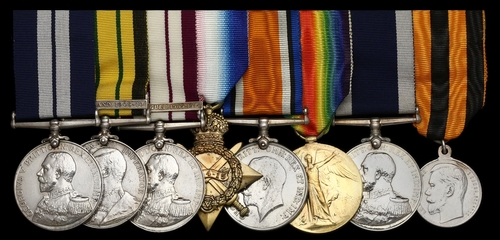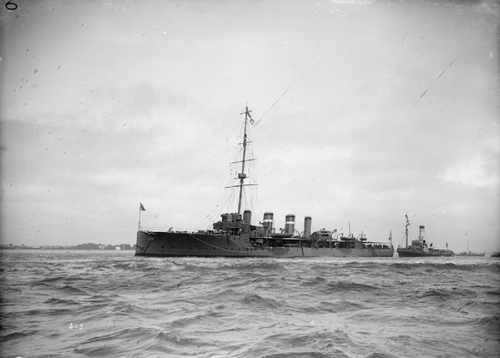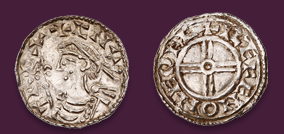Auction: 25002 - Orders, Decorations and Medals
Lot: 161
The impressive 'Minelaying 1917' D.S.M. campaign group of eight awarded to Able Seaman J. B. H. Anderson, Royal Navy, who was present at the Battle of Jutland with H.M.S. Blanche and unusually remained an Able Seaman for the duration of his two-decade naval career
Distinguished Service Medal, G.V.R. (192430. J. B. H. Anderson. A.B. Minelaying Operations. 1917); Africa General Service 1902-56, 1 clasp, Somaliland 1908-10 (192430 J. B. H. Anderson, A.B. H.M.S. Hyacinth.) number officially re-impressed in places; Naval General Service 1915-62, 1 clasp, Persian Gulf 1909-1914 (192430. J. B. H. Anderson. A.B. H.M.S. Hyacinth); 1914-15 Star (192430, J. B. H. Anderson, A.B., R.N.); British War and Victory Medals (192430 J. B. H. Anderson. A.B. R.N.); Royal Navy L.S. & G.C. (192430. J. B. H. Anderson, A.B. H.M.S. Actæon.); Russia, Imperial, Medal of the Order of St. George, 4th Class, officially numbered '1272358', mounted as worn, contact marks and some with edge wear, overall very fine (8)
D.S.M. London Gazette 17 May 1918.
James Boyd Hendry/Hendric Anderson was born in Perth, Scotland on 5 July 1881. He made his living as a painter's assistant prior to joining the Royal Navy as a Boy Class II, serving at shore establishment H.M.S. Caledonia from February 1897. Two years later on his eighteenth birthday Anderson formally engaged with the Royal Navy to complete twelve years of service. He was rated Ordinary Seaman with H.M.S. Resolution shortly afterwards, and was later advanced Able Seaman whilst serving with H.M.S. Ocean from 1901. Most unusually, Anderson would retain this rating for the remainder of his long career in the Navy.
He was posted to 'Highflyer'-class protected cruiser H.M.S. Hyacinth in February 1907 to serve in the Somaliland Campaign off the coast of East Africa. Anderson remained with Hyacinth when she was stationed in the Persian Gulf to put a stop to the illegal arms trade in the area. He would have been on board for the so-called 'Hyacinth-incident' in December 1910, in which a British guns-raid on a Dubai townhouse devolved into street fighting with the townspeople. Hyacinth began a bombardment of Dubai in order to relieve its men and allow them to return to the ship.
Anderson joined H.M.S. Blanche in late 1912 and served with her for nearly the duration of the Great War, until April 1919 when he was posted to H.M.S. Boadicea. Blanche was a 'Blonde'-class scout cruiser with eight 4-inch guns and served in several battleship squadrons during the First World War. She was present at the Battle of Jutland in 1916, where he was assigned to a position at the rear of the battle fleet but did not engage in any fighting. Regardless, Anderson was awarded his Russian Medal of St. George for Bravery for his part during Jutland. Following the Battle, Blanche was converted to a minelayer in 1917 and she took part in 16 minelaying operations during the war. Anderson earned his D.S.M. for his service in these sorties.
Anderson's long naval career came to an end but a few years after the close of the Great War. His final posting was at the shore establishment H.M.S. Actaeon, where his WWI medals were sent to him, as well as his L.S. & G.C. medal. He was with Actaeon from 24 April 1920 until his discharge on 8 August 1921.
Thereafter Anderson moved to London where he was married on 29 January 1922, only six months after his discharge, to Mary Caulfield at St. Philip in Lambeth. The couple was living at 48 Brook Street at the time. Anderson found work with the Royal Mail as a skilled workman in the engineering department from 10 July 1925, and five years later was promoted to skilled workman class II. Anderson unfortunately suffered from health issues, being absent from work for a hundred days in 1933 due to illness. He retired the following year at the age of 53 in consequence of ill-health and applied for a superannuation, at the time also receiving a pension of 22/- per week from the Royal Navy. Anderson died two years later on 16 June 1936 and had spent the final years of his life residing with his wife at their home on 10 Brassey Square in Battersea; sold together with copied research.
Subject to 20% VAT on Buyer’s Premium. For more information please view Terms and Conditions for Buyers.
Sold for
£1,700
Starting price
£600







